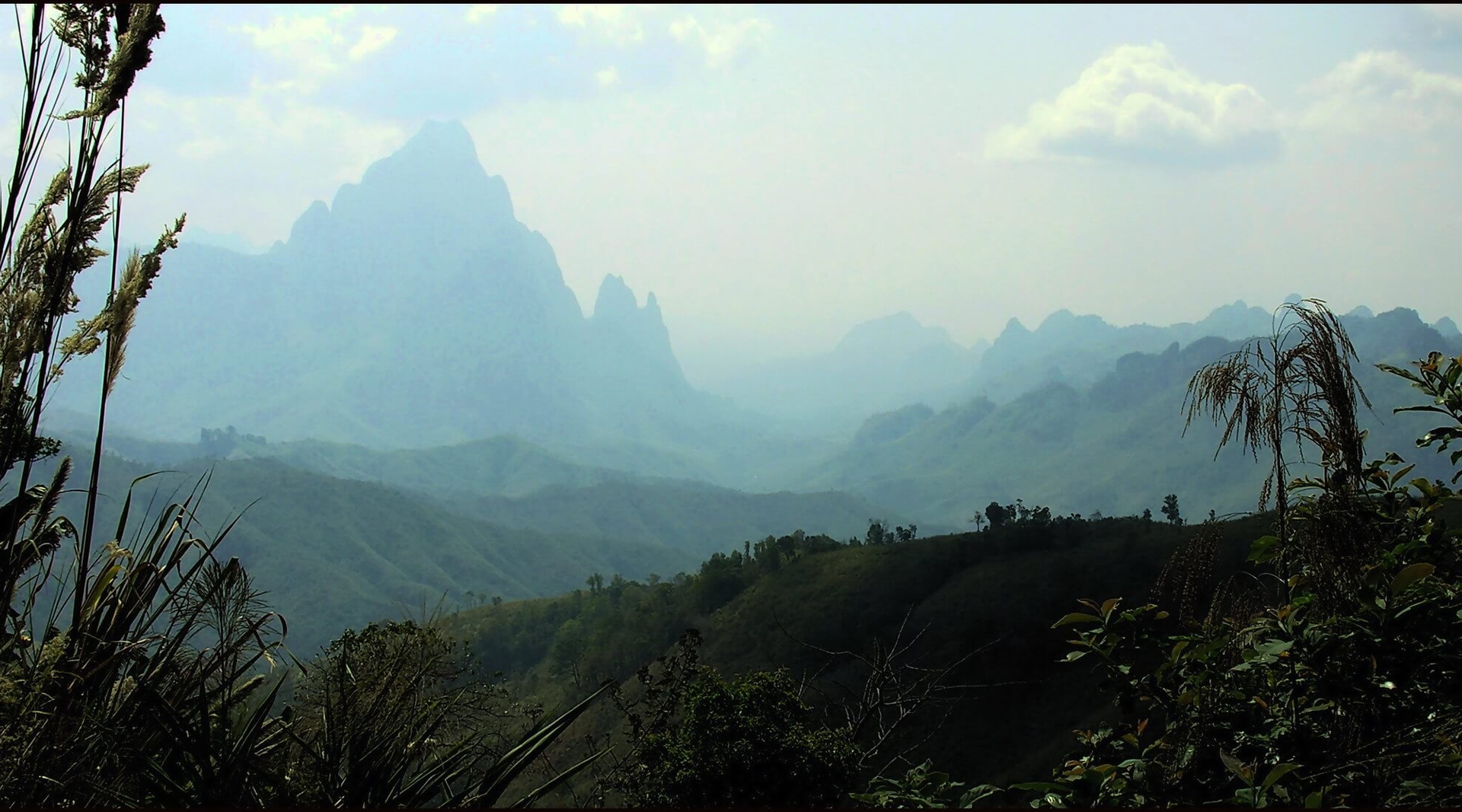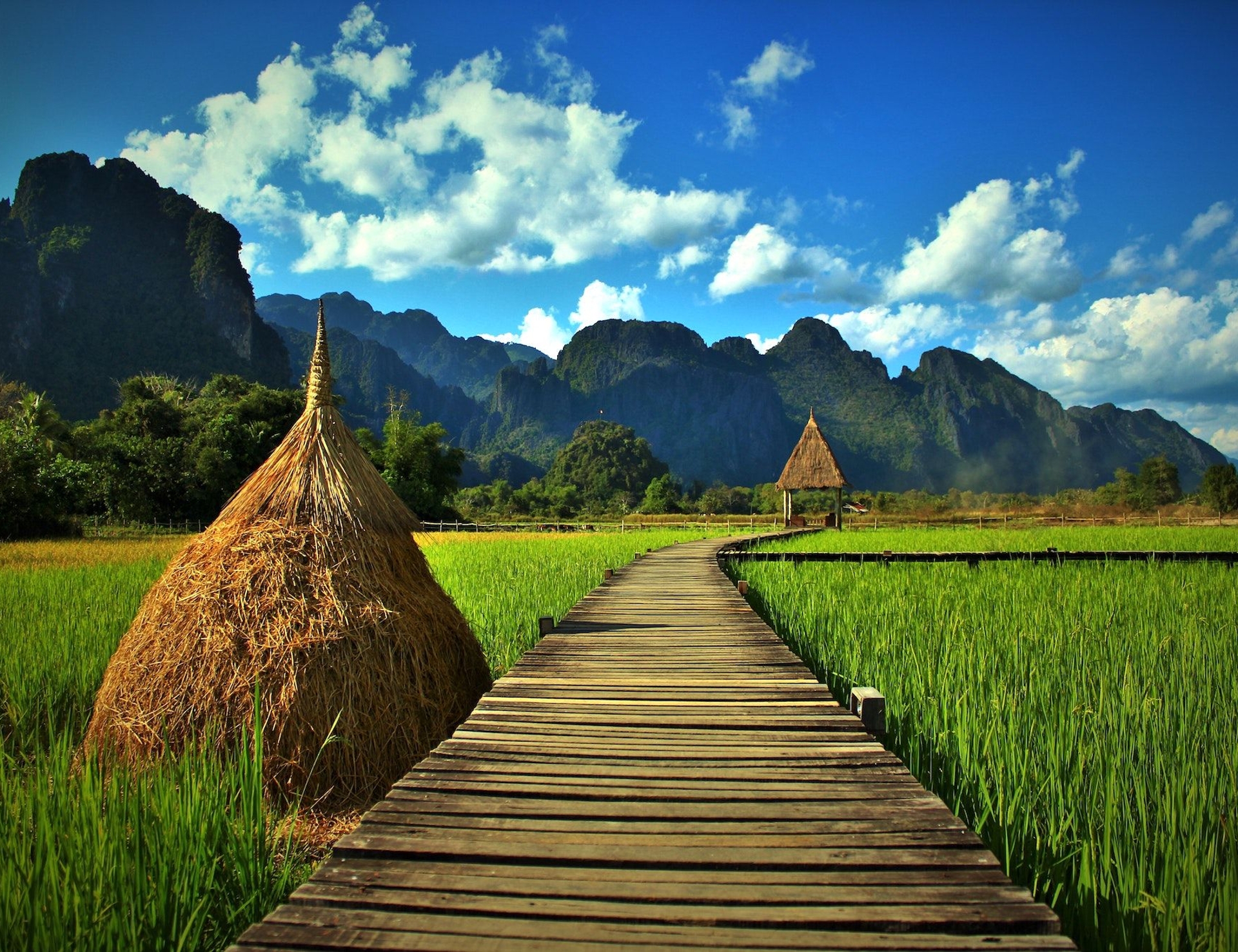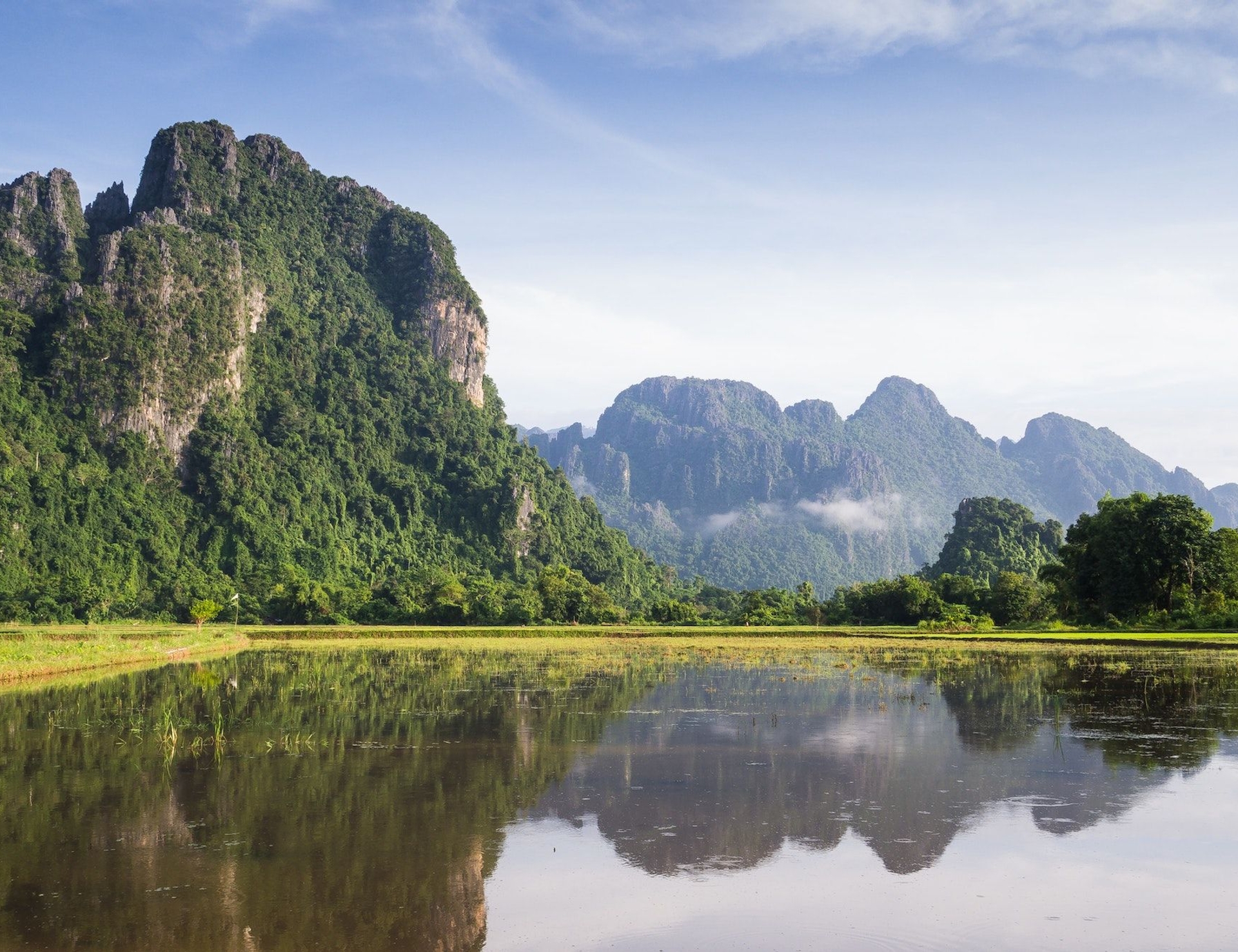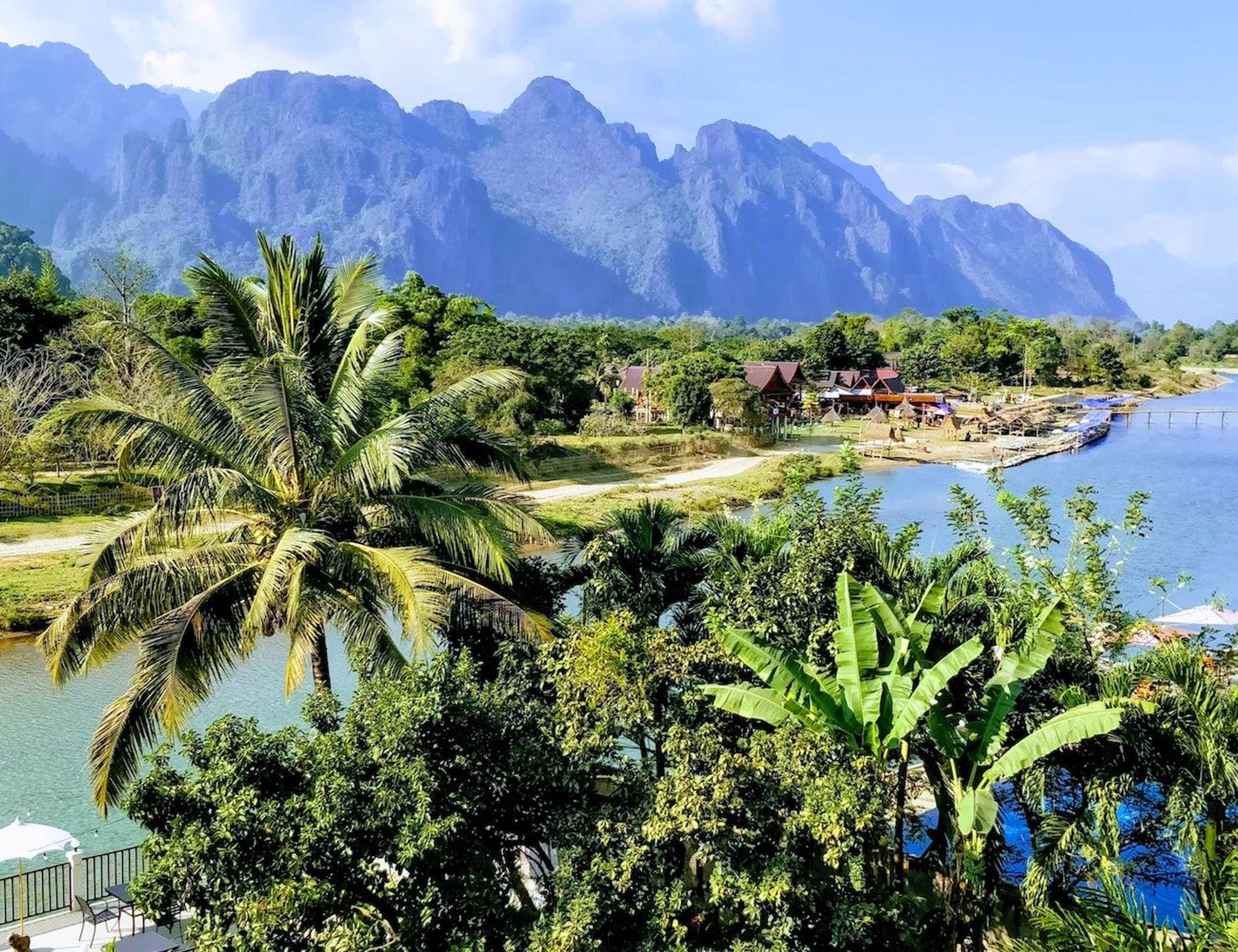
Cycling guides | Last updated:
The Complete Guide to Cycling in Laos
By Kamalpreet Singh •
Table of Contents
- 1. Understanding Laos
- 2. What Makes Laos Unique for Cycling?
- 3. What are the Best Places to Cycle in Laos?
- 4. What are the Best Cycling Routes in Laos?
- 5. When is the Best Time to Cycle in Laos?
- 6. Enjoying Laotian Cuisine
- 7. Laos Visa Requirements
- 8. Vaccines and Medicines
- 9. Handy Info
- 10. Through the Notes
- 11. Embrace the Laos Cycling Adventure
Understanding Laos
Laos is a landlocked country in Southeast Asia located between 14° and 23°N, and longitudes 100° and 108°E. The country shares its borders with Vietnam, Cambodia, Thailand, Myanmar, and China. Vientiane is its capital and largest city.
Most of Laos is mountainous and unsuitable for human habitation. As a result, the majority of its 7.5 million inhabitants live along the Mekong river that flows through its western border with Thailand.
Only 4% of the total land in Laos is arable, and the country is less prosperous than its Southeast Asian neighbors.
What Makes Laos Unique for Cycling?
Laos is one of the most densely forested countries in the world. With almost 72% of its total land area under forests, Laos has more forest cover than any other country in Southeast Asia. By comparison, Vietnam has about 47% forest cover, Cambodia 51.56%, Thailand 31.68%, and Myanmar 63.64%.
Laos is also extraordinarily mountainous, with only 10% of the country located below 600 ft.
With a population density of only 33 persons per square km, Laos is also the least densely populated country in Southeast Asia. By comparison, neighboring Vietnam has a population density of 319 persons per square km, making it almost 10 times as crowded as Laos.
Laos has a relaxed and laid back culture. So much so that the country’s official name — Laos PDR — which stands for Laos People’s Democratic Republic, is jokingly referred to as Laos People Don’t Rush.
This combination of dense forests, high mountains, sparse population, and a laid back culture makes Laos stand out from every other country in Southeast Asia for cycling.
DREAMING OF CYCLING IN LAOS?
Explore our amazing bike tours in Laos now!
What are the Best Places to Cycle in Laos?
Laos offers a wide range of cycling experiences, from serene rides along the Mekong River to challenging mountainous terrain. Here are some of the best regions to cycle in Laos:
- Northern Laos
Northern Laos is known for its beautiful mountains and dense forests. It is home to the highest mountain in Laos, Phou Bia (2820m) as well two out the three UNESCO World Heritage Sites in Laos. Towns like Nong Khiaw and Muang Khua are popular points for northern cycling adventures. More specifically, a northern Laos cycling trip should include the following destinations:
Luang Prabang: Luang Prabang is a UNESCO World Heritage site noted for its medieval Buddhist temples, dating back to the 16th century, which blends in seamlessly with 18th and 19th century French colonial architecture. The city serves as a starting place for biking in Northern Laos and is a visual spectacle, being located at the confluence of the Mekong and Khan rivers, with the mountains of northern Laos surrounding it on three sides. Explore the historic town, visit ancient temples, and cycle along the banks of the Mekong and Nam Khan rivers. The nearby countryside features lush landscapes and traditional villages.
Luang Namtha: Located close to Laos’ northern border with China, Luang Namtha is a popular destination for biking and hiking trips into the surrounding countryside. The terrain is relatively flat, while mountains loom in the distance. Visitors get to ride through villages inhabited by eight of Laos’ several ethnic groups, including the Hmong and Lanten people. At each village, visitors can experience at close quarters the traditional handicrafts of the village tribe, such as embroidery, basket making, cotton weaving, bamboo papermaking, etc. The scenic Nam Dee waterfall is another attraction.
- Southern Laos
Vat Phou and Si Phan Don Islands: The Vat Phou temple complex was built between the 10th-14th centuries by Hindu kings of the Khmer empire. It is a UNESCO World Heritage site that rivals the Angkor Vat temples of Cambodia. Located some 143 kms to the south of Vat Phou are the Si Phan Don Islands, a group of 4,000 scenic islands within the Mekong river provides a peaceful and picturesque setting for cycling. The terrain is relatively flat, making it suitable for cyclists of all levels.
Bolaven Plateau: The Bolaven Plateau is an elevated region rising 1000 to 1500m above the sea level. It is known for its numerous waterfalls, lush greenery and numerous coffee plantations. Coffee was introduced to the region by French colonialists in the early 20th century, and today it produces high quality Arabica and Robusta coffee. Cycling in this region allows you to ride through serene countryside, dense forests, and past numerous waterfalls. The rolling hills provide a moderate challenge.
What are the Best Cycling Routes in Laos?
-
Northern Laos to Vientiane: This is a classic northern Laos loop that starts from Luang Prabang before heading north east to the picturesque town of Nong Khiaw and then heading to Vientiane. Nestled between two mountains with the Nam Ou river flowing between, Nong Khiaw is a paradise for trekkers and mountain bikers. The route then heads south west to Oudomxay which offers a range of adventure activities such as zip lining and abseiling, before returning to Luang Prabang.
-
Luang Prabang to Vientiane: This is a classic Laos cycling route that covers the three most visited destinations in Laos — Luang Prabang, Vang Vieng, and Vientiane. Starting from Luang Prabang in the north, the scenic routes takes a riders through Laos’ hallmark limestone karsts, rice paddies, a blue lagoon at Vang Vieng, the Nam Ngun lake, and all the way down to the banks of the majestic Mekong river at Vientiane.
-
Chiang Mai to Luang Prabang: This route starts from Chiang Mai in northern Thailand and ends up in Luang Prabang in northern Laos after taking a north-easterly course. The crossing from Thailand to Laos is made on a boat across the Mekong river in the Chiang Rai province of Thailand.
-
Hanoi to Luang Prabang: This cycling route starts from Hanoi in Vietnam and moves westward to Luang Prabang in Laos. The landscape consists of mountains, rice paddies, and tea plantations. The crossing from Vietnam to Laos is made at the historic town of Dien Bien Phu.
PLANNING A CYCLING HOLIDAY IN LAOS?
Dive into our curated Laos cycling adventures today!
When is the Best Time to Cycle in Laos?
The best time for cycling in Laos is between October to March. The average temperature hovers between 25-28 °C with plenty of sunshine. From June to September, the rainy season sets in, making cycling difficult. Here are some general guidelines for the best times to cycle in Laos:
- Best Season: October to February
- This is considered the best time for cycling in Laos.
- The weather is relatively cool and dry, making it comfortable for cycling.
- Daytime temperatures are milder, and you'll experience less rainfall.
- This season is ideal for exploring most regions of Laos, including the lowlands, Luang Prabang, Vientiane, and the Mekong River areas.
- Shoulder Season: March to May
- While it can be hot and dry, especially in the lowland areas, it's still possible to cycle.
- Early mornings and late afternoons are the most comfortable times to ride during this season.
- Be prepared for high temperatures and potentially scorching sun.
- This season is suitable for regions like the Bolaven Plateau and the 4000 Islands, which provide cooler microclimates.
- Off-Season: June to September
- The rainy season can vary in intensity, with heavier rains from July to September.
- While cycling is still possible in some areas, particularly in the northern and central regions, you should be prepared for wet conditions and occasional flooding.
- Trails and roads may become muddy and slippery, so mountain biking or off-road cycling may be more suitable during this season.
- It's advisable to avoid areas prone to flooding and landslides during heavy rains.
Enjoying Laotian Cuisine
Laotian cuisine is centered around the consumption of sticky rice, which is an inseparable part of the everyday life of the people of Laos. In fact, Laos has the highest per capita consumption of sticky rice in the world. Expect most items on the local menu to come with a generous serving of sticky rice, then.
Some essential Laotian dishes to try on your visit include:
-
Larb: Larb (also called laab or laap) is so popular in Laos that it is sometimes called the national dish of Laos. It is made by cooking meat with sticky rice and herbs. The meat used varies by geography, but most commonly Larb is prepared using either fish, pork, or beef.
-
Nam Tok: The word Nam Tok literally translates to “waterfall”, and that is what this dish resembles the most. A meat salad dripping with juice, Nam Tok, like Lab, can be prepared using different kinds of meats. However, unlike Lab, it is always soupy. Added dressing includes ground roasted rice, fish sauce, shallots, and mint. It is eaten, as with everything else in Laos, with sticky rice.
-
Green Papaya Salad: Also known as Tam Som, green papaya salad is made by slicing unripe papaya into thin slices, then mixing it with ground chili, fish sauce, and palm sugar, all of which are pounded in a mortar before being mixed with papaya.
-
Beerlao: Beerlao is the name under which beer prepared by the Lao Brewery Company (LBC) is cold in Laos. Since LBC has a nearly 99% share of the liquor market in Laos, this is the most common form of liquor available in Laos. Beerlao is today exported to several countries including the UK, USA, Canada, and Australia.
-
Lao lao: Lao lao is the traditional rice-based whiskey popular in the Laotian countryside. Like all things Lao, it is prepared by fermenting sticky rice, and is often consumed communally from large earthenware pots.
Laos Visa Requirements
A Laos eVisa is required for entry at any of the nation’s international ports of entry. These include the border crossings from Thailand and Vietnam. Laos has three international airports — at Vientiane, Luang Prabang, and Champasak respectively.
Visitors can apply for a Laos eVisa on the government’s official visa application portal. They will need to upload copies of the following documents:
- Passport cover page
- Passport bio page
- A photograph of the applicant measuring 4x6cm
Visa processing time is usually three business days.
If you plan to enter Thailand or Vietnam from Laos, you will need to apply separately for visas to these countries. Refer to our detailed Thailand and Vietnam cycling guides for the visa application requirements for these countries.
Other important things to note about the Laos eVisa:
- Laos only offers single-entry visas for tourists
- The Laos eVisa is valid only for 60 days from the date of issue, and the stay period is 30 days
- The arrival date should be no more than 60 days from the date of applying
- Visitors should carry a printed copy of their eVisa at the time of entering Laos.
Vaccines and Medicines
The US Centre for Disease Control and Prevention (CDC) recommends travelers to Laos get routine vaccinations for the following:
- Chicken pox
- Diphtheria
- Shingles
- Influenza
- Measles-mumps-rubella
- Polio
- Hepatitis A and B
Additionally, it is recommended to have rabies vaccination before traveling to Laos as stray dogs and monkeys are fairly common. Malaria is a risk in southern Laos, especially the Champasak province, and in riverine areas. If you are visiting Laos in August-September, make sure to take preventive measures against dengue.
Handy Info
Currency
The Laotian Kip (LKP) is the official currency of Laos. As of Oct 2023, 1 USD = 20,661 LKP. The USD is accepted at several commercial establishments. However, it is advisable to carry some local currency with you as well. The USD can be exchanged for LKP at airports, border crossings, and designated money exchanges.
Most ATMs will dispense LKP.
Additionally, if you are carrying USD 2500 or its equivalent in a foreign currency into Laos, you must declare the same at the port of entry.
Transport
Major Laotian cities such as Vientiane, Luang Prabang, and Pakse are connected by air. Buses and trains are cheap options for intercity travel. However, they may not be very comfortable.
The Lao-China bullet train is a good option for tourists looking for a premium intercity travel option. The train starts from the capital Vientiane and heads north to the city of Boten on the border with China. Along the way, it passes through the major tourist destinations of Vang Vieng, Luang Prabang, Oudomxay, and Luang Namtha. From Boten, the train enters the Yunnan province of China and goes all the way to Kunming.
For commuting within cities, tuk-tuks are convenient. Tourists can also rent motorbikes for commuting within major cities.
Language
Lao or Laotian is the official language of Laos. English is understood in most tourist centers. Due to its colonial past, French is also spoken and understood by a segment of the population. Signboards in most places are usually in both Laotian and either English or French.
Culture and Religion
Buddhism is the largest religion in Laos with 66% of the population identifying as Buddhists. Tai folk religion consisting of animistic beliefs is the second most popular belief system in Laos.
Laos is officially a communist state, one of the last remaining communist republics in the world today. It follows a one-party political system, and is closely allied to China on the international stage.
Soccer is the most popular sport in Laos. Also popular are traditional martial arts such as Muay Lao, that are similar to kickboxing and Muay Thai.
Appliances and Devices
Electricity in Laos is supplied at 230V and 50 Hz. This is the same voltage that is used by most countries in the world except those in North America and Japan.
Make sure to check the back of your device to check if it is compatible with the local voltage supply. If not, you might need a voltage converter.
Hotels in Laos have the two-pin power plug sockets of Type A,C, E, F and the three-pin Type B. These sockets are used in Thailand, Cambodia, and Vietnam as well.
If your device does not plug into any of these sockets, you might need a travel adapter.
Mobile Coverage
Laos has good mobile network coverage at 4G speeds in its cities. The remote mountainous areas, however, may not have good coverage.
Lao Telecom and Unitel are the largest mobile carriers in Laos. Visitors can make international calls from Laos and access mobile internet as long as their international roaming is activated. For longer stays, buying a local SIM card is advised.
Time Zone
Laos follows the GMT+7 time zone, also known as the Indochina time zone. This timezone is also followed by Thailand, Vietnam, and Cambodia.
What You May Find
Waterfalls, Buddha statues, Buddhist monks, rice paddies.
Through the Notes
Read: The novels of Colin Cotterill, set in 1970s Laos, the Ramayana, whose Laotian version known as Phra Lak, Phra Ram is the national epic of Laos
Listen: Alexandra Bounxouei, Laotian singer, and the UNDP’s Goodwill Ambassador for Laos
Eat: Larb, considered Laos’ national dish
Watch: The Rocket, a Tribeca award winning Lao language film by the Australian director Kim Mordaunt
Drink: Beerlao, the ubiquitous beer by the Lao Brewery Company
Embrace the Laos Cycling Adventure
A spectacular, yet little expired destination for cycling, Laos promises plenty of adventure. Even if you’ve been to other Southeast Asian countries before, you can expect Laos to be an experience unlike any other.
READY TO CYCLE LAOS?
Get started with your cycling adventure now!




